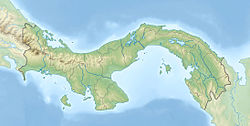The Tuira Formation is a geologic formation in Panama. It preserves bivalve, gastropod and sponge fossils dating back to the Tortonian period (Clarendonian to Hemphillian in the NALMA classification), from 11 to 9.5 Ma.[1][2]
| Tuira Formation | |
|---|---|
| Stratigraphic range: Tortonian (Clarendonian-Hemphillian) | |
| Type | Formation |
| Location | |
| Coordinates | 8°30′N 77°42′W / 8.5°N 77.7°W |
| Approximate paleocoordinates | 8°12′N 76°18′W / 8.2°N 76.3°W |
| Region | Darién Province |
| Country | |
| Type section | |
| Named for | Tuira River |
Fossil content
editAmong others, the following fossils have been reported from the formation:[2]
See also
editReferences
edit- ^ Aguilera et al., 2017, p.5
- ^ a b Tuira Formation at Fossilworks.org
- ^ Beu, 2010, p.156
- ^ Aguilera et al., 2016
- ^ Schwarzhans & Aguilera, 2016
Bibliography
edit- Aguilera, Órangel A.; Schwarzhans, Werner; Béarez, Philippe (2016), "Otoliths of the Sciaenidae from the Neogene of tropical America", Palaeo Ichthyologica, 14: 7–90, retrieved 2019-02-09
- Beu, A.G (2010), "Neogene Tonnoidean Gastropods of Tropical and South America; contributions to the Dominican Republic and Panama Paleontology Projects and Uplift of the Central American Isthmus", Bulletins of American Paleontology, 377–378: 1–550, retrieved 2019-02-09
- Schwarzhans, Werner; Aguilera, Órangel (2016), "Otoliths of the Ophidiiformes from the Neogene of tropical America", Palaeo Ichthyologica, 14: 91–124, retrieved 2019-02-09
